Update 08/06/2022 :
Baking log
---
Hello,
Starter is 3 days old (50% T150 whole wheat / 50% water). Below is what I did each day :
Day 1 (+24h) - Nothing happened. Only stir.
Day 2 - Bubbly, but probably leuconostocs (or whatever other bacterias, but not yeast yet). Very small refresh (70% inoculation = 70g sourdough, 15g water, 15g whole wheat).
Day 3 - Nothing happened.
Question :
What would be the best way to proceed now ? If I understand correctly, I must keep pH quite low, i.e. not refresh too much.
1. Just do a small refresh (2:1:1 or 6:1:1) every other day, and simply stir on the day without refresh ?
2. Just stir every day, without refresh, until there is a few bubbles.
Thanks a lot !
The best way to proceed depends on the temperature at which you cultivate your starter's microflora.
All starter recipes are temperature dependent. Some starters are created at low temp, others depend on moderate or high and very high temperatures. It depends.
Thanks for your reply : Temperature is 77°F.
Even if temperature varies, doesn't the principle stay the same : don't overfeed during the first days in order not to dilute acidity ?
Once you get first rise due to leuconostocs (= or others bacterias not directly interesting for sourdough), should we do :
- 50% refresh every day (i.e. : 50g starter, 25g flour, 25g water).
- 50% every over day
- Just stir every day until sourdough is ready.
Thanks for your reply :) At 25C/77F you can (and should) refresh 50:25:25 three times per day.
If you want your lactic acid bacteria to grow, then you have to dilute acidity. Or else they won't grow. They need rather high pH to grow. And sourdough starters are all about lactic acid bacteria, because we can buy yeast with ease but not sourdough lactic acid bacteria.
Good luck with your starter! You are using fresh milled flour, so it's a bit different.
Wow, won't 3 feedings per day completely dilute acidity (= rise pH) and prevent good bacteria development ? This seems contradictory with the famous Debra Wink's article who clearly states we should aim at lowering pH (= don't overfeed) when creating a starter.
Now that I had the "leuconostoc rise", I thought I should just do a small refresh (2:1:1) every 24h, possibly skipping if no activity (= no bubbles).
If your starter temperature is indeed 77F around the clock and your starter smells stinky cheesy, then yes, refresh 1s:0.5f:0.5w 3 times per day. It can be every 8 hours (8:8:8h), or 12:6:6hours, or even 16:4:4, or 12:8:4, do it as is more convenient to you, to your schedule of sleep and daily activities.
Do it even if you do not believe in it, EIiott, as an experiment.
Again, sourdough is all about bread specific lactic bacteria and they won't grow once pH falls below 4.0. Do not let your starter's pH fall below 4.5-4.0, which is already distinctly acidic to taste, feed it. Once you have them plenty, yeast is almost an afterthought, they will grow explosively.
A whole wheat starter made from water and flour does not take more than 2-3 days to make from scratch if your room temperature does not fall below 77F. If it does, then 4-5days max. But it takes rather frequent refreshments, to keep pH above 4.0 - 4.5.
P.S. Thank you for putting leuconostoc rise in "" "". Poor innocent leuconostoc species have nothing to do with it. They do not have such powerful gassing power and do not develop first. Leuconostoc species are normal sourdough starter bacteria and make great sourdough bread but they do not make bread dough rise. Nor do they stink.
The initial gassing, acidification and stench from the starter are due to the fecal bacteria found in soil and on the surface of the grain and to bacillus subtilis, also known as hay bacillus or grass bacillus. They are the first to develop when you mix flour with water, but they completely die out within the first 24-48hours of the starter's life when bread specific lactic bacteria take over.
Is made up of both "good" and bad bacteria. While it is true SOME leuconostoc bacteria will be found in sourdough starters and other fermentations others are not so friendly, are the cause of the bad aroma in a starter in the first few days and can be harmful.
Abe, the lab tests show that by the end of the first 24hours of spontaneous fermentation of the whole grain flour and water mix six different genera of acid and gas producing bacteria grow in the mix. Leuconostoc is just one of them and in a minority, totally insignificant.
70%of that initial bacterial mass is of genus enterococci, fecal bacteria. Hence the bad smell. But they, stinky enterococci, are also very powerful acidifiers which is good, they naturally sterilise the initial sourdough better than pineapple juice for sure. If the starter is then refreshed 1:10, then by the end of the next 24hours nothing is left of those initial six genera (nothing here means less than 3%) and all microflora is already "good" sourdough microorganisms, typical of sourdough bread.
Please see this article
The evolution of lactic acid bacteria community during the development of mature sourdough
Why insist that it is not minor and insignificant amounts of normal sourdough leuconostoc spp that grow there initially but some bad smelling leuconostoc overgrowth that routinely causes that stench and initial acidification? Is there some research that confirms it?
I've had starters that mature very easily with no off smells. I had my best experience with a locally grown heritage wheat (in the UK) called Maris Widgeon. Went something like this...
After this it went from strength to strength. It just turned into a starter with no issues.
I've had others which have been a lot slower and/or a bad aroma in the first few days.
If a starter does have an off aroma there's reason to believe it's leuconostoc activity as well as other bad bacteria. For that is what they do. Cause off smells. Without testing every single starter it is a logical conclusion. Now how to go about proceeding onto the next feed is another topic. I was only talking about bacteria which causes off smells in the initial mix.
If, as you say, theses "bad" bacteria are a necessary evil in the progression of a starter then why do away with them all (or almost all) in the very first feed? Shouldn't we be using them to our advantage? Allowing them to turn the starter acidic so the yeast that comes with the fresh feeds have a favourable environment to really take hold.
If made starters relatively quickly (although never as quick as the maris widgeon flour) by not going crazy with the feedings and have slowed down starters by feeding too much too soon.
Thanks for this discussion.
Now, what is the consensus on 3 vs 1 refresh / day when trying to create a new starter ?
Since the key point of Debra Wink's famous article is :
"Before yeast, don't feed too much; after yeast, don't feed too little."
One could think that 3 refresh / day will completely dilute acidity and prevent yeast to develop ?
Where are you up to? And how much have you got?
Taking both of our comments into account i'm thinking... to give it a slightly bigger feed (24 hours after the last time) but just enough to do away with the bad smell but not such a lot it's an overdose.
So keep 50g and feed 25g water + 25g flour. If that does away with the cheesy smell then fine. If not slowly add in a bit more water and flour till it's more pleasant. Give it a very good stir and keep warm. Do not feed again till you se activity. Best of both worlds.
There is no consensus on the number of refreshes/day. Each recipe for developing a starter from scratch plays with three variables: temperature, frequency and volume of refreshment (feed) in its own way. I only suggested 3/day because you seem to like 2:1:1 refreshment of 50s:25f:25w and your room temperature is 77F.
Generally speaking, people choose recipes that suit them psychologically (their beliefs about how thing should be and should be done) and situationally. If you can refresh only once per day, because you are a researcher in the lab who works 9 to 5, you would not use a recipe with a 3/day refreshments. If you are a baker in a bakery that works 3 shifts, never sleeps, you might as well choose a recipe that requires refreshments every 2.5-3 hours and be done in a day ending up with a perfect starter ready to bake with.
Everything is about reading the starter. When making a starter we are given what we are given and taking variables into account we feed according to the starters needs. Two people might do exactly the same thing and get different results.
Flour is always 100% and everything else is a percentage to the flour.
So what you mean is equal parts flour and water by weight which is Flour 100% and Water 100% which makes it 100% hydrated.
I would have left the initial mix till it bubbled up. Which might take a day or two. Then given it a bigger feed (although not a big feed like maintaining \a starter) after which only re-feeding when seeing activity or a daily regimen of a modest feed but still more than you have stated.
For instance...
Initial mix: 50g flour + 50g water. Leave till it bubbles up.
Then a daily feed of keeping half (50g) and topping it back up by feeding 25g water + 25g flour. Keeping it warm at around 75-78F.
Then once you have a stronger starter which bubbles up every time it has been fed then increasing the feeds.
No one way is the only way but there are some good guidelines to follow. Your starter needs food but at this young stage you don't wish to dilute it too much so a nice balance should be found. Feeding too much will slow down the process as the starter needs to become acidic and you don't wish to be throwing out all the good stuff. But at the same time the bacteria and yeasts do need food. So feeding 70g starter with 15g flour is quite poor. But feeding 50g starter with 25g flour isn't too much or too little. Enough to ensure the bacteria and yeasts have food but not too much it upsets the balance. Once your starter has matured then it'll need bigger feeds.
Thanks for your detailed answer. Please find below some comments :
This step is done : I have not refreshed the initial mix until it bubbled up. Now, when I mentioned a 50% refresh, I meant 50g starter, 25g flour and 25g water, as you specify (i.e. : starter is 50% of the total weight).
Ok, I was afraid that 50% refresh would dilute acidity too much, that's why I tried a 70% refresh initially.
Temperature here is 77°F. Would you prefer a 50% refresh everyday or every other day (and just stir on the day without refresh) ?
take off 50g and top up with 25g water + 25g flour that is called a 2:1:1 feed. A poor feed for a strong starter but a good feed when trying to make a starter.
77F is perfect.
Once every 24 hours giving it a feed of 2:1:1 if you see some activity. Skip a feed if all goes completely quiet and just give it a stir.
Thanks !
So for the last two days, I simply did a 2:1:1 refresh every 24h (I also stirred every 12h).
24h after the refresh, there is no activity (maybe 5 bubbles on the top, but I don't know if it's some activity or bubbles that were slowly released after the mix), The starter is quite relaxed/fluid, with an unpleasant smell (cheesy).
Not sure if I should skip 1 or 2 refresh or keep feeding every 24h ?
Just add in a little flour, by the tsp, until it has thickened up and it isn't so runny. Try using wholegrain flour. Give it a very good stir and then cover. See what it does over the next 24 hours.
Thanks. I will try this and update.
Two years ago, a starter I made rose after 20 days ! I think it's because I used big feedings too early (1:1:1 then 1:3:3) from days 3 to 15. At day 15, I switched to 2:1:1 feedings as I was advised, and 5 days later (at day 20) starter finally rose.
So, hopefully here, something will happen within the next few days ;)
12h after last refresh. Cheesy smell has completely disappeared. Smell is more neutral now, perheaps a little bit sour ? No activity yet, just a dozen of small little bubbles.
Give it a very good stir and keep warm.
24 hours after the last feed just give it a few teaspoons of flour, and perhaps a little water but only if it gets too thick, if it hasn't shown anymore activity.
12 hours after last refresh, nothing had happened. It smelled like a mix of fresh flour and water.
A few hours later, it developped a strong acetone smell.
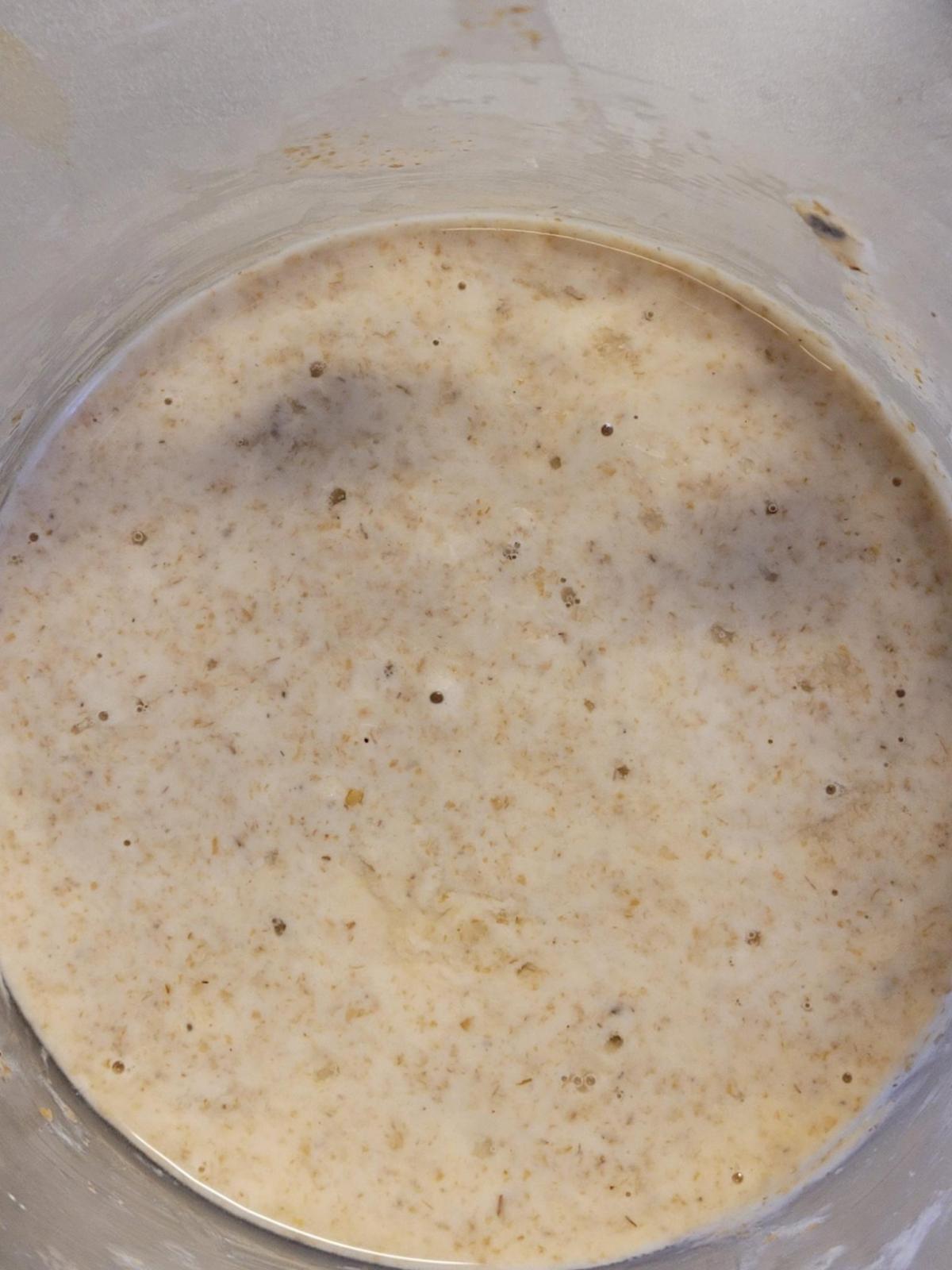
Now we are 24 hours after last refresh. There are no bubbles (or very few on the top, but not below or on the side). Still a strong acetone smell, which disappeared after I stirred.
It feels like I should just stir tonight instead of refreshing ?
Feed again 50g starter + 25g water + 25g flour (+ a little extra to make it a little thicker).
Acetone does mean it needs a feed.
Ok, I will refresh it tonight then. I was afraid to rise pH and delay the process : what do you think about it ?
It's about to surprise us and bubble up. I believe it does need to be fed, due to acetone smell and some bubbles, and a a feed of 2:1:1 will be fine. How warm is it where you are?
currently so about 78°F (25.5°C). Maybe down to 73°F (23°C) within the next days.
I live in London.
You too had fires lately... :/ This morning, I could smell the smoke from fires near Bordeaux, and I'm 300 km away ! Hopefully today was the last day of that heat wave
Just in time as fires did break out today in numerous locations but I think the heatwave will break by tomorrow. To be able to smell the fires 300km away is testimony to how huge they were. Scary!
This morning, 12h after last refresh, starter already developped a strong acetone smell. Also, when I stirred, I felt the starter was quite bubbly (but not really stringy), for the first time.
I can't say for sure if it expanded a bit because I made a mistake : my recipient is too large (so starter is like 1 cm thin) and I didn't marked it's level after refreshing. So I moved the starter to a narrower recipient.
Tonight at refresh, starter was again a little bubbly (still not stringy), expanded a little (like 10%/20%) and had a timid but pleasant smell of beer/fruit.
Tomorrow morning, it should be more obvious if the starter expands !
I'm a bit surprised because two years ago, the change from "no bubbles, no rise, and sour smell" to "completely bubbly and stringy, strong beer/fruit smell, at least doubled" was much more abrupt/sudden.
This time, the transition seems to happen gradually.
I can't wait to see how it will be tomorrow !
20 days and you're only on day 8 of this starter which isn't too long at all. It's sounds as if it's ready to bubble up. 10-20% risen from just a few bubbles on top 24 hours ago is very promising. And of course if your container is so big and the starter only comes up to 1 cm it'll be very difficult to read. I like the fact it has changed from acetone to fruity and beery.
Hope you did a 2:1:1 refresh plus adding in a little extra flour if it needs thickening up.
If you see come tomorrow, 12 hours after this feed, a significant rise then you can try another 2:1:1 feed. If not, then wait the 24 hours. I'm thinking this one might surprise you yet.
Keep at it. 8 days is not that bad for timing. Well within normal parameters. 20 days is a bit long.
Indeed, a 2:1:1 refresh tonight.
Oh yes, it's definitely an improvement compared to last time ! I meant, I was surprised that this time, changes seem to happen more gradually. But after all, it's only the second time I create a starter (not counting all the failed attempts), so there's a lot to learn.
I can't wait to check it tomorrow morning ! As excited as a kid waiting for the tooth fairy (in France, we have "a little mouse", not a fairy ^^).
And still love the feeling one gets when you see it come to life.
Know exactly what you mean. It's an achievement and very satisfying when you see patience pay off.
Lol... I don't think many people would be quite as happy to have a mouse paying a visit.
(Left : at refresh, Right : +12h)
So +12h after refresh, starter is quite bubbly, it rose +40%/50%. I have not stirred it yet, so unsure if texture is stringy. Maybe it will keep rising in the next hours, I will check that.
Don't be too concerned about the stringiness. That'll be more to do with gluten and hydration. Keep an eye on it and when it begins to fall give it another feed. I'm debating switching to 1:1:1.
Let's see how it progresses.
Yesterday at +16h after last refresh, starter was past its peak (around 50% rise) so I did a 2:1:1 refresh.
I had to move to another location so could not check much, but this morning nothing really new : bubbly starter, about 50% rise, beer/fruit smell. I did a 1:1:1 refresh, with a new whole wheat flour (probably better quality).
We will see !
Might give more rise because there's less overly fermented and more fresh flour. Now that your starter is alive and kicking it will benefit from a larger feed. Not too much too soon but a 1:1:1 feed is a good progression. See how that goes. If it peaks in over 12 hours but under 24 (say 16 like the last feed) then try stirring it down and see how much more it rises in those 8 hours. If it peaks within 12 hours then do another feed.
+12h after refresh, starter has not reached peak yet (or maybe close but I will check tomorrow morning). It has never been this bubbly. Temperature is still around 25°C (77F).
What should we aim before increasing the feedings : should it reach its peak much sooner and rise much more than 50% ? What will help get it more active : regular 1:1:1 feedings ?
For now, it's still "slow" and rise by not more than 50% (perheaps less, not sure since bottom of recipient is not quite straight).
Hydration and flour used might not rise as much as a stronger flour that's thicker at the same hydration. It certainly looks healthy to me and while doubling is a good indicator it's not the be all and end all. However your starter is still young and will benefit from further feedings. Looks healthy to me.
Keep up with the 1:1:1 feedings and lets see how it responds. Perhaps give it a little more flour before bed to thicken it up and it has a little extra food until you can feed it again in the morning.
Give it a good stir while adding in a teaspoon of flour at a time till it's a little thicker. What was this feed?
Thanks ! It was a 1:1:1 this morning.
Starter + Water + Flour?
30g starter, 30g flour, 30g water.
Previously, when I used 2:1:1 feedings, it was 50g starter, 25g flour and 25g water.
I think another feed tonight will be fine...
Try...
It is active and leaving it for 12 more hours might be too long. So take off 60g starter (and keep it as back-up in the fridge) and feed the remaining 30g. Your starter will now be 80% hydration.
Don't worry as the discard in the fridge will be your fail safe. And if all goes well you can either discard it or for now on store all your discard in the fridge to use up in other recipes (but don't store for too long).
Starter had developed an acetone smell, which was replaced by a pleasant beer/fruit smell as soon as I stirred. Also, it had begun to fall a bit. So peak is reached in about 12h I think.
80% with whole wheat (T150) felt quite stiff !
Let's check tomorrow morning ;)
Is always a sign it needs feeding. And if it began to fall then it had peaked. I think it's going well.
Let's see what this new feeds brings. Your starter is young. I think this is what the acetone smell is. One normally finds it in young starters but not as usual in older starters. Give it time.
Bonsoir :)
12 hours at 85F will rise much faster than 12 hours at 70F, etc. Mostly when folks talk about a starter doubling in X hours (8 or 12), they're assuming the ambient temp is in the mid to high 70F range. If you're doing this in a 68F room things will move slower. 88F? Much faster.
About 12h after refresh, starter nearly doubled. I made a refresh (30g starter : 35g flour : 25 g) a few hours later, by the end of afternoon. +4h after last refresh, starter is already bubbly, and has risen a bit (< 10%).
Should I wait a bit before increasing feedings and slowly switching to T65 flour ?
I'm a bit surprised peak is reached in 12h, shouldn't it reach peak faster ? Tomorrow, I will check every hour to properly measure peak time.
Looking good to me. Give it time! It's strengthening and looking even better than this time yesterday.
What flour are you using now?
Keep with this feed at 12 hourly intervals till you see it speed up and then we'll switch up the feed again.
Did the acetone smell come back? If that has now gone then a further proof it's heading in the right direction.
I'm using whole wheat flour (T150) since the beginning.
No acetone smell is good. Why not use a 50:50 mix of wholegrain and white for the next feed?
I'll start the transition tomorrow then. A quick question I had in mind :
Let's say you have two starters :
- Starter A : refreshed at 1:1:1 ( = 33 % inoculation ratio)
- Starter B : refreshed at 1:5:4. ( = 10 % inoculation ratio)
Both reach peak in 10h. What would be the difference between using starter A at 33% in a dough VS starter B at 10% ? Shouldn't it lead to the same result (and same bulk fermentation / proofing times) ?
Let's get a bread from it first.
this was just a question out of curiosity =D
Of using a starter that was fed 1:1:1 and took 10 hours to peak.
1:5:4?
Ratios for starters given like that would mean Starter:Water:Flour. So do you mean 1:4:5 as in 80% hydration like you're doing?
10 hours for a starter or levain fed at a ratio of 1:4:5 is absolutely fine to use.
OK, this answers my question, thanks !
This feed:
Was just converting your 100% hydration to 80% hydration.
For your next few feeds just do 1:0.8:1 be that 30g starter + 24g water + 30g flour or 40g starter + 32g water + 40g flour.
And if it's 77F, is it that all 24 hours or is it cooler at night?
Time to peak is temp dependent (other stuff being equal).
Regardless, that looks good, so I'd do 2x feedings per day and probably make them 1:2:2 or 1:3:3. I'd stick with whatever whole grain flour you have (rye, wheat etc).
The key is to get on a routine and let the starter really establish itself, so don't vary things much for a week or so. Also, I'd try baking with that and see how you like the result.
As soon as it speeds up from peaking in 12 hours. Every time it gets stronger I would suggest a higher ratio. At the moment it's 1:1:1 twice a day because it's taking about 12 hours to peak. As soon as it reduces the peaking time then the next step is 1:2:2.
a constant 73°F currently.
Aside from temp, the other thing about hitting peak is that it will hit peak when it's consumed all the new food (i.e. the flour you've added at the last feed). So, it will take longer to hit peak if you give it higher ratios, less time at lower.
I don't mean to harp on temp, but it if dips from 73 to, say, 68 at night, that will affect the overnight doubling time. This isn't bad, but it will make peaking from the evening feeding longer that getting to peak from the morning feed since daytime is noticeable warmer.
Today, peak was reached between 9h and 10h after the refresh made this morning (1:0,8:1). Forgot to take a picture, but it nearly doubled, and was really bubbly. Temperature 77F again.
Tonight I just made another 1:0.8:1 refresh. I will be able to check starter in 8 hours.
It's getting there. You kept it a bit warmer and it doubled in a good amount of time. I'd expect it to be quicker but it's not too slow either. If in 8 hours time it has doubled or near enough then I think increasing the feed would be the next step.
Try...
1:1.6:2
In other words you're increasing the flour to twice the weight of the starter and keeping it at 80% hydration. E.g...
If that's not too much for the container you're using.
If it goes well then perhaps plan a midweek test bake.
So this morning it nearly doubled. It may have been able to rise a little more, so 8h/9h to reach peak in total. I did a 1:1.6:2 refresh (50:50 whole/white).
Checked 8 hours later close to peak (picture below : red lines for min/max). A few hours later, it didn't rise much more : so let's say a peak time of 8h/9h. However "only" 80% rise today.
Tonight did another 1:1.6:2 refresh.
Sides slope! It's not a perfectly straight glass. If it was that would be at least doubled and in 8-9 hours with a 1:1.6:2 feed.
Coming along nicely. See how it does by morning. If the same as in the picture then increase the feed.
1:2.4:3
I'm definitely in favour of a midweek bake. How about Hamelman's Vermont Sourdough?
I was thinking about Forkish's overnight country blonde, but will read Hamelman's Vermont to compare.
I was wondering : Let's say starter peaks in 8 hours. Does it mean that bulk fermentation + proofing should take 8 hours (or perheaps a little more because of the salt that slows things down a bit) ?
Also, starter will be tomorrow at 15% inoculation (1/(1+2.4+3)) and my recipe calls for 10% inoculation : should I wait that feedings of my starter match those 10% inoculation (by increasing them little by little, as we are doing) ?
Are not fermented to the same level as final doughs. Although how fast your starter works still gives you an idea how it'll perform in the final dough. Your starter is not overly fast so don't expect your dough to need les time than advised in a recipe and possibly more time.
As for matching a starter feed to being the same as a starter % in a final dough. Good idea (to get an idea of how it'll perform) but not a necessity. Starters are simply how we store the yeast and bacteria to keep the process going.
For now lets see how it performs each time we increase the feed. It looks healthy and I have no doubt it'll leaven bread. As for the timings of a recipe that's only a guideline anyway.
I'm happy how it's proceeding.
:)
That looks fine. Don't get too obsessed with 'well it was only 90%, not double' etc. That starter looks fine. I'm with @abe - time for a midweek bake. C'mon, I'm firing up the oven to 450 tomorrow and it's due to be 91F. Let's be bake buddies.
I'm all for a midweek baking trial. Eliott's starter looks healthy to me. Only way forward now is to try it.
Why not do a bake together and share a recipe with you guiding him, Clevins?
I think it would make a good one to try out. This is pretty simple. It's a 50/50 whole wheat loaf with no add ins. You can bake this in a pan or free form as a boule or batard.
If your room is warm, you can just add the water as is, but if it's fairly cool, microwave the water so that it's lukewarm. Don't worry about precision, we just want the initial dough temp in the 70s. Mix the water and flour but nothing else. Mix until there are no dry bits of dough visible, but no farther. You're not developing the dough here, just getting the flour and water in contact. Cover and let it sit for 60-90 minutes. This autolyse seems to help fermentation as enzymes do their magic.
At the end of the autolyse time, add in all the starter and mix. After the starter is pretty well incorporated, add the salt and keep mixing. I actually use my Kitchenaid here and mix on stir or speed 2 for about 5 minutes. When the dough starts clearing the bowl you're good.
Put the mixed dough in a lightly oiled bowl, cover and set a timer for 30 minutes. After 30 minutes, come back, wet your hands (important! Wet hands prevent the dough from sticking to them) and do a set of stretch and folds. Cover, come back in 30 and repeat. Do this once more for a total of 3 times and then evaluate the dough. Is it resisting stretching? Let it go. Is it loose and very easy to extend? Do another set of S&F at the 2 hour mark.
After the last set of S&F, cover and let it sit. Check it every once in a while. You want to let it ferment enough, but not go too far. I look for 30-50% rise, some bubbles and for the dough to feel jiggly not firm. This part just takes practice but err on the side of letting it go a LITTLE too long vs cutting it off. In a 75F or so room (23-25C) my doughs seem to take 4 to 6 hours. Start checking it 4 hours in, about 2.5 hours after the last S&F.
Once you're done with bulk, dust a work surface with some flour and turn the dough out. Be gentle - try not to degas if you can avoid it. Gently shape it into a round that holds its shape but isn't super tight (this is another thing you just need to get a feel for). Leave it for 10-20 minutes. Come back, shape it and plop it into a pan or banneton depending on how you plan to back it.
Cover that with a loose plastic bag or even wrap. You want to avoid the dough touching the plastic while also keeping air away from the dough so it doesn't try out. Put in fridge overnight.
*About flour choices...This is pretty flexible but I'd keep it simple for your first several loaves. The main thing is to have at least half the dough be a high protein flour. So, you could also do this as with 50% bread flour/50% AP or just 100% bread flour. Or you could do some variation of WW/Bread/AP. Get your technique down first, then experiment with flour combos if you want.
To be continued...
Today, starter is not performing as well as previous days (see last log). So not sure I'll bake tomorrow yet !
After the refresh of yesterday evening, it took about 12 hours to reach peak. I did another 1:1.6:2 refresh this afternoon, and 10 hours later, previous peak is still not reached (current : green line). I think it will rise for 2 more hours. I will check tomorrow morning if it rose to last peak at least.
Beer/fruit smell was replaced by a more "neutral" one (bread smell ? not sure how to describe) since 2 refreshes.
Temperature is about the same as when it reached peak in 8h/9h (75F to 77F), for the same refresh.
And often to get the aroma one needs to break the surface.
If you can give it two more hours then fine. I'm sure it'll peak by then and give it another feed. I think you should try a bake.
How about making a levain using a bit of the discard after tonight's feed?
I was referring to the one after this afernoon's stir.
I will only be able to refresh it tomorrow morning and then hopefully resync to a refresh every 12 hours.
I will plan a bake by the end of the week, hopefully starter will get some activity back.
Loads of bubbles. I think it might surprise you and make a lovely loaf. But if you wish to see it through to the weekend then fine.
The best way to tell where a starter is at is trying a bake.
Just before feeding again tonight take a little off and try a float test. Even though it still won't be 100% proof as there are reasons why a perfectly healthy starter might not float but if it does it'll put your mind at ease.
for the peak tonight. I will only be able to refresh it tomorrow morning.
Is it better to refresh it now in this case ?
then refresh. See where it's at tomorrow morning. Try a float test.
I finally did a 1:1.6:2 refresh tonight. It rose by perheaps 60% in 12h/13h (picture). Not sure why it seems to get weaker after each refresh (peak is lower and lower, and time to reach peak does not improve) : should I switch to smaller refreshes a bit ? Flour was a mix of 20g whole and 40g T65.
Temp is about 77F during the day, and now falling to 73F during the night.
I just did another 1:1.6:2 refresh. We will see tonight.
Oh, and I forgot : it passes the float test !
But passes the float test. Contradicting!
How about you keep this feed and do not feed again till it peaks. If it peaks before 12 hours then at the 12 hour mark. If more than 12 hours then leave it till the next feed.
1) It will rise more slowly overnight (depending on how fast it cools).
2) You're in analysis paralysis mode. The goal isn't to culture some perfect starter then bake. It's to culture a good starter and bake.
This will sound harsh but... *bake something*. Quit worrying about perfection. Don't play with 0.1 ratio differences. Make this easy on yourself... feed it 1:2:2. The 1:1.6:2 thing is just too twee.
I've seen this before - I spend time on another food forum where some of us are bakers and a new guy there got in this same trap. But when he baked a loaf? It was very good. Bread is the point of all this. Make some.
It just means 80% hydration. A bit less hydrated than 100% done in order to perceive more rise. It sounds twee but it is just a ratio. The bigger the amount of starter the less twee it'll be. Just easier, and quicker, than saying 40g starter + 64g water + 80g flour.
However I agree 100% that a loaf should be baked. One can be stuck in the phase forever aiming for a perfect starter. Whenever I make a starter as soon as I see it's bubbling up every time it is fed i'll bake a loaf. Typically within a few days of the initial mix. I also don't make too much fuss over the feedings however the ratios were a guide and easier to convey than eyeballing it.
And it Eliot wants a slightly stiffer starter, fine. But I guess what I'm trying to get at there is that there's no magic feed ratio, etc.
Just advised to make it 80% hydration and the ratios were just easy to write instead of writing out a formula.
No magic feed whatsoever! In fact I often make starters without ever measuring anything. But when guiding someone they need more exact figures.
After a few days without update, here is some news !
1) Troubleshooting the starter
Last update was at day 15, where starter rose slowly (> 10h) and not much (< 50%) at 77F with 1:1.6:2 refreshes (with a mix of whole wheat and T65).
I decided to go back to 100% whole wheat at 1:1:1, to see if starter could gain more activity. After a few of such refreshes, starter was indeed quicker and quicker to rise. Little by little, I increased the refreshes. I introduced T65 flour only when starter was quite active with big refreshes (from 1:3:3).
Now, at 77F, starter peaks (double to triple) in 7h/8h with 1:1:4:4 (1 : whole wheat, 4 : T65).
2) Let's bake
Recipe I followed was "Overnight country blonde" by Ken Forkish.
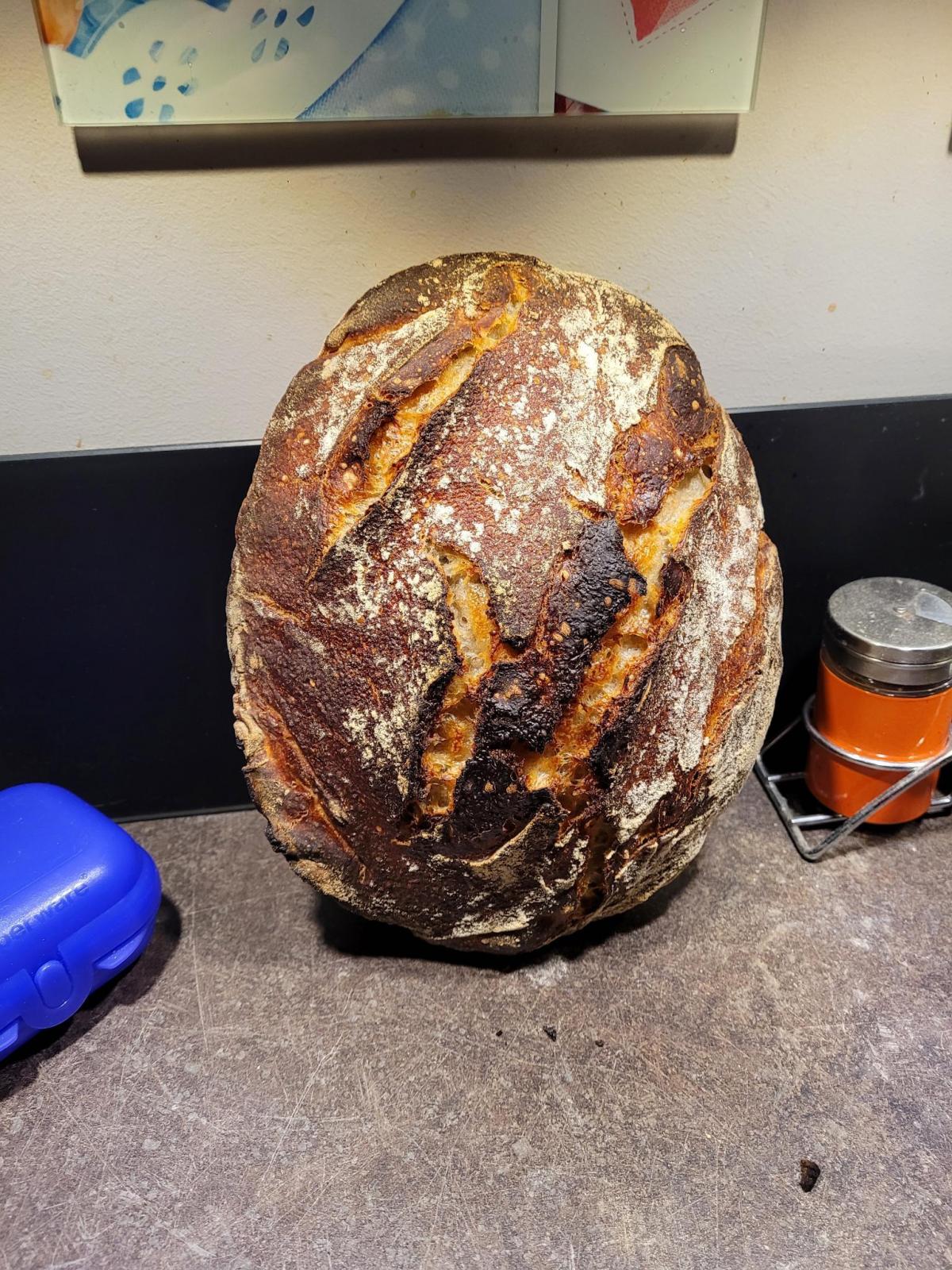
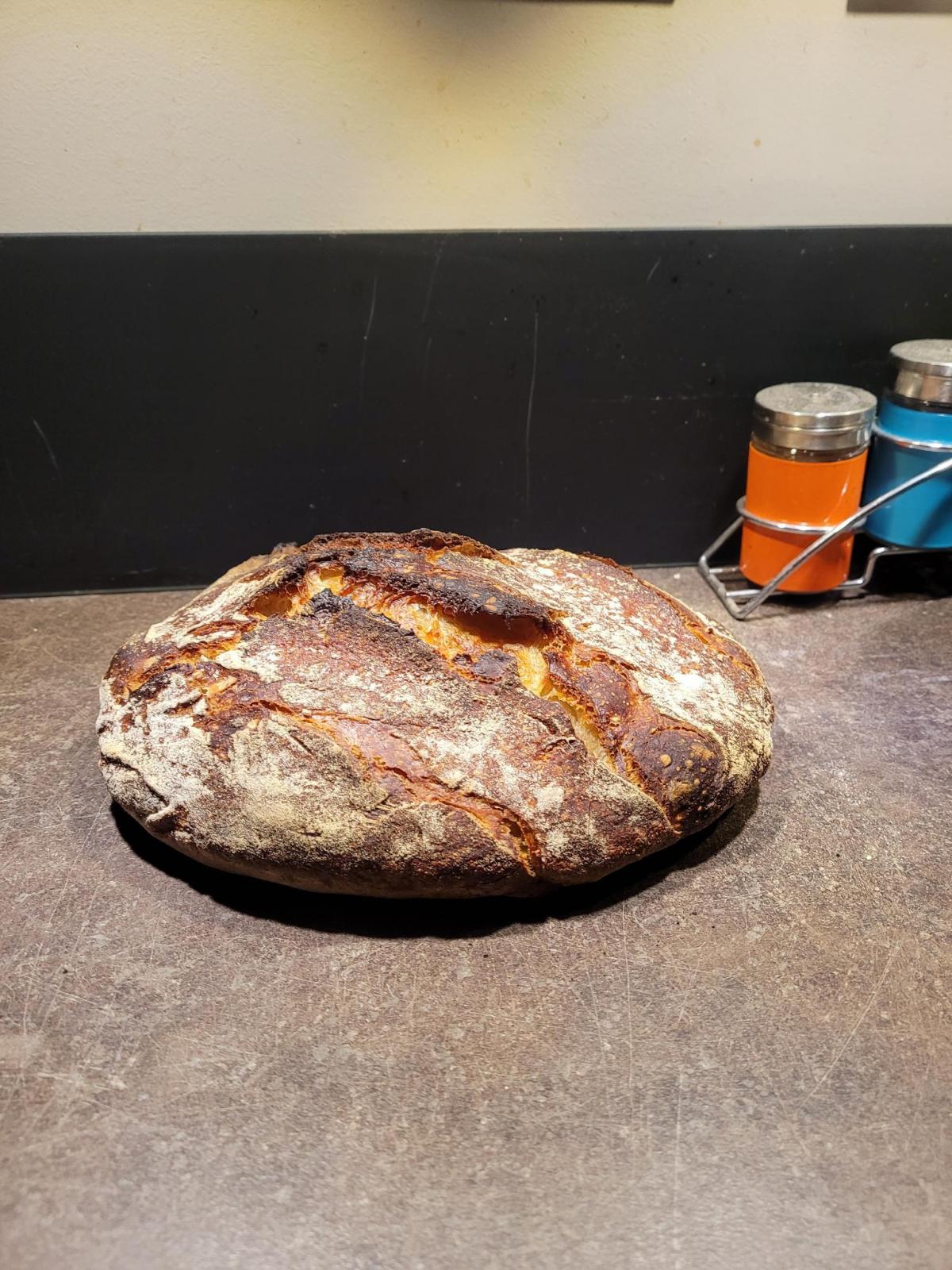
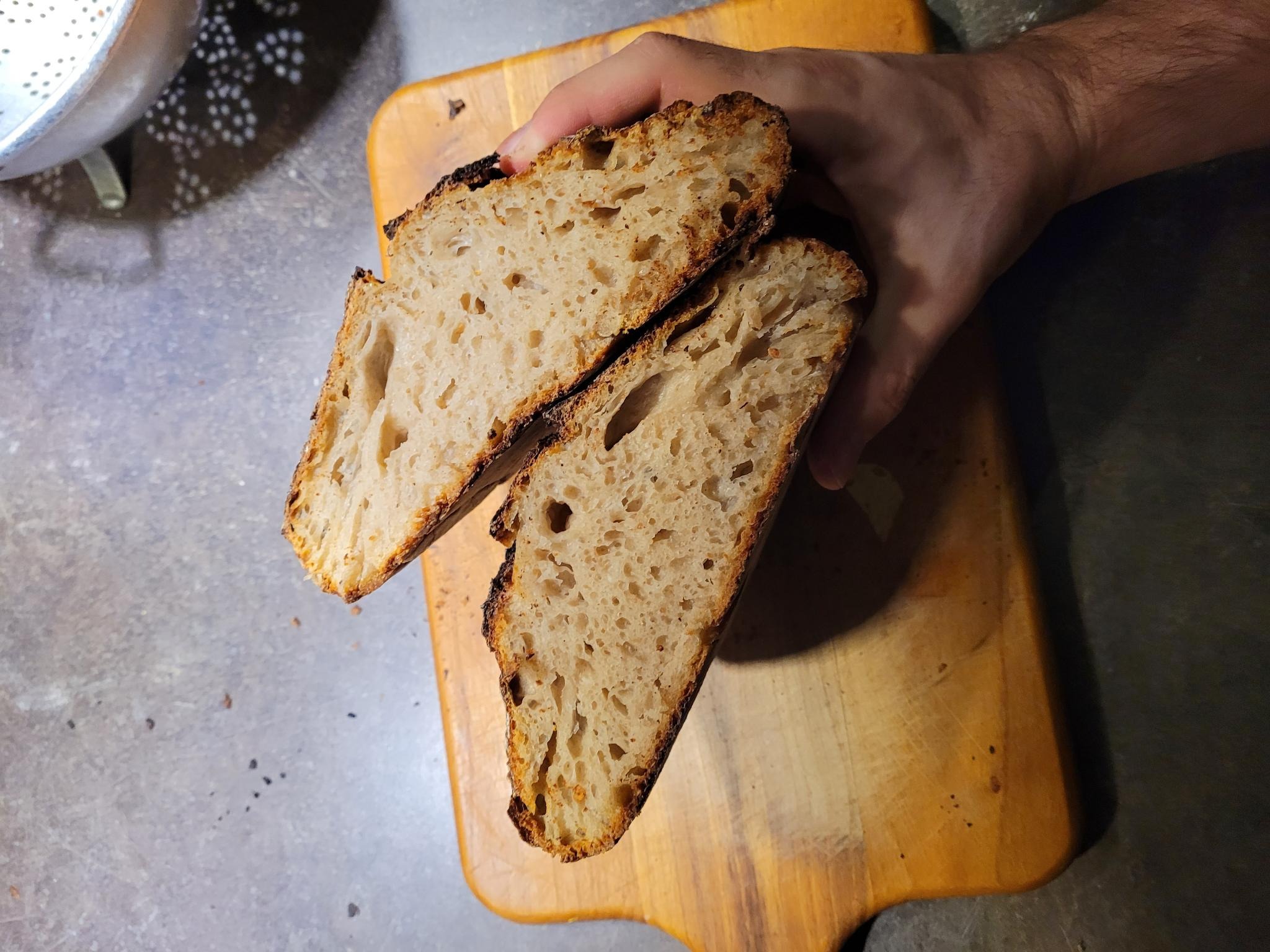
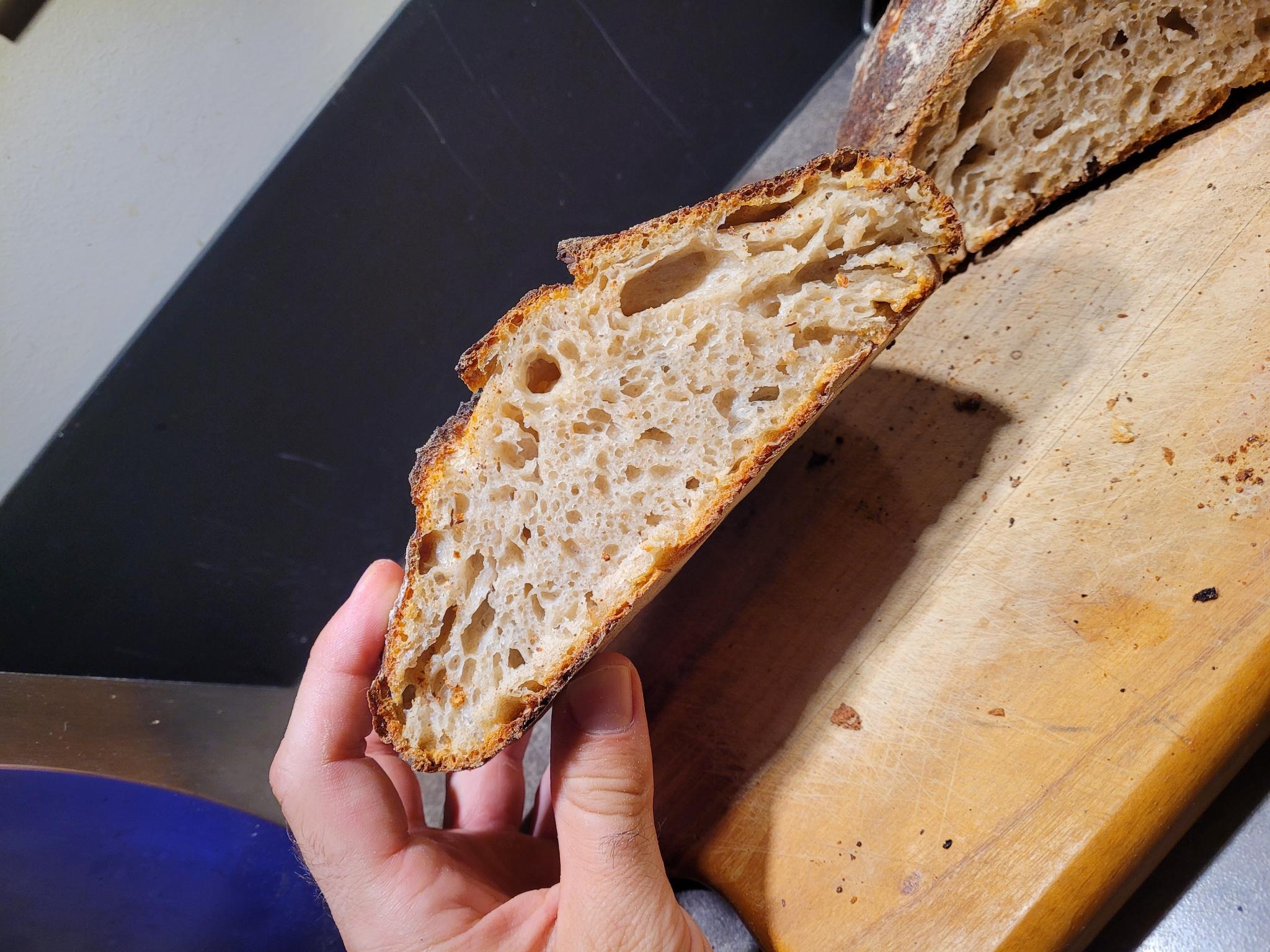
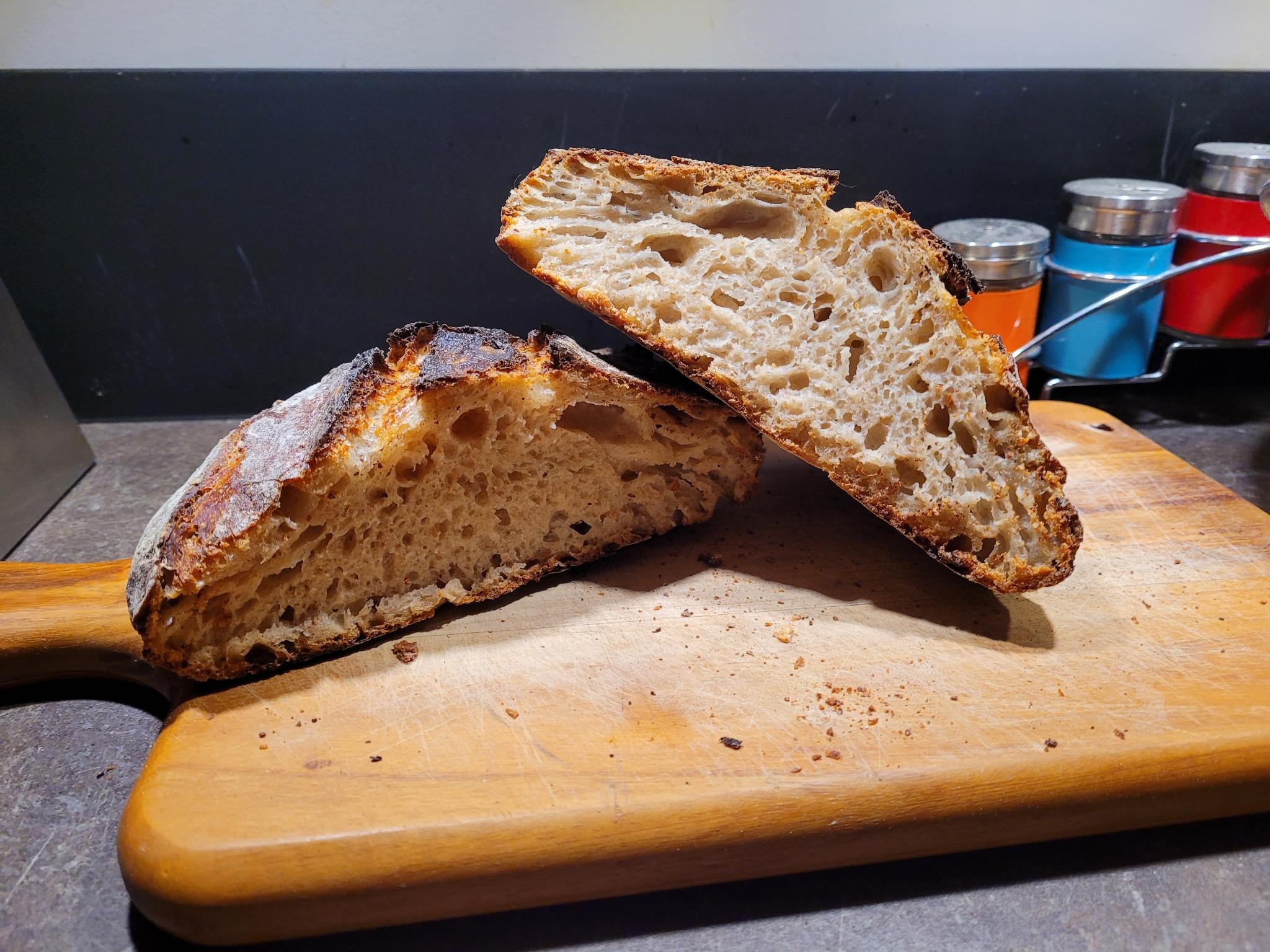
- 108g starter (used at peak)
- 402g T65 wheat
- 25g T110 rye
- 13g whole wheat
- 11g salt
- 335g water (instead of 342g in the recipe)
30 mn autolysis. 5h30 bulk fermentation (78F) (4 stretches and fold every 20mn at the beginning). Shaping the loaf, and then 17h in the fridge (was not at home, so had to use fridge). 1h30 proofing at room temperature (77F).
Baked 30mn in the dutch oven with the lid, 20 mn without the lid. 1h singing (!). Here is the result :
A few notes / questions :
Shaping was quite difficult : dough was really sticky, wet and did not hold much (it spread out quite fast...). After proofing, same thing (wet / flat / sticky / difficult to handle ).
At first, I didn't want to bake it, thinking it would be a disaster. Well, the loaf is indeed quite flat, but it is delicious ! :) But after some overnight rest, crumb is a bit chewy/sticky.
For the next loaf, I would like to get much more rise / more open and less chewy-sticky crumb :
- I will try to remove perheaps 5% to 10% of water, maybe it will help ?
- Maybe the dough is overproofed/underproofed ? Not sure how to evaluate this.
- Since starter peaks in 8h, I wanted to bake after 7h/8h total fermentation (even if salt is supposed to slow down fermentation) : 5h30 bulk + 2h30 proofing (i.e. : 17h in fridge + 1h30 at room temperature = about 2h at room temperature ?) : So 8h in total. Does that seem right ? After proofing, loaf seemed to pass finger dent test (but I'm never really confident about that).
Just tried a second bake today, same recipe but with 10% less water. Dough was much easier to handle !
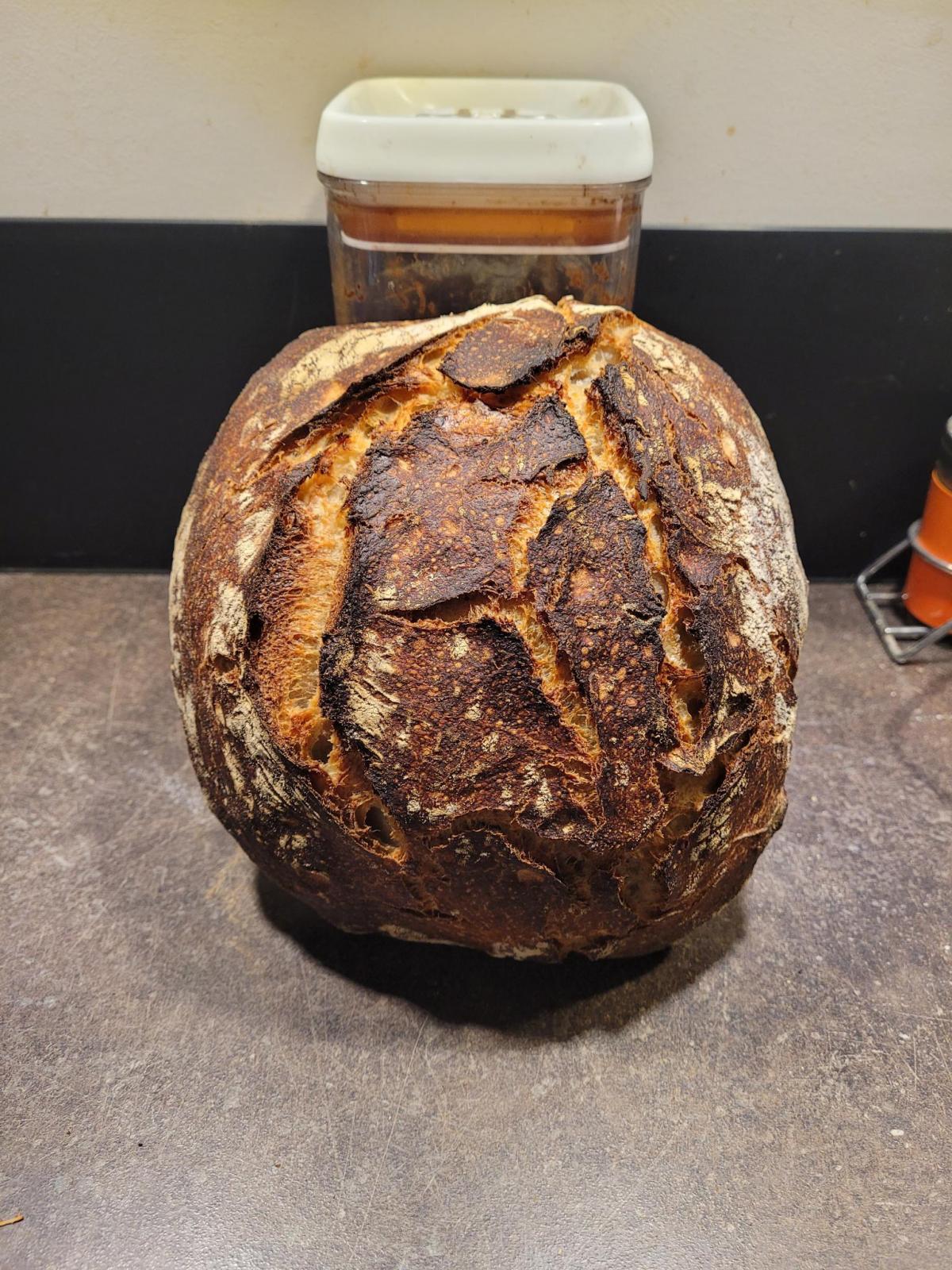
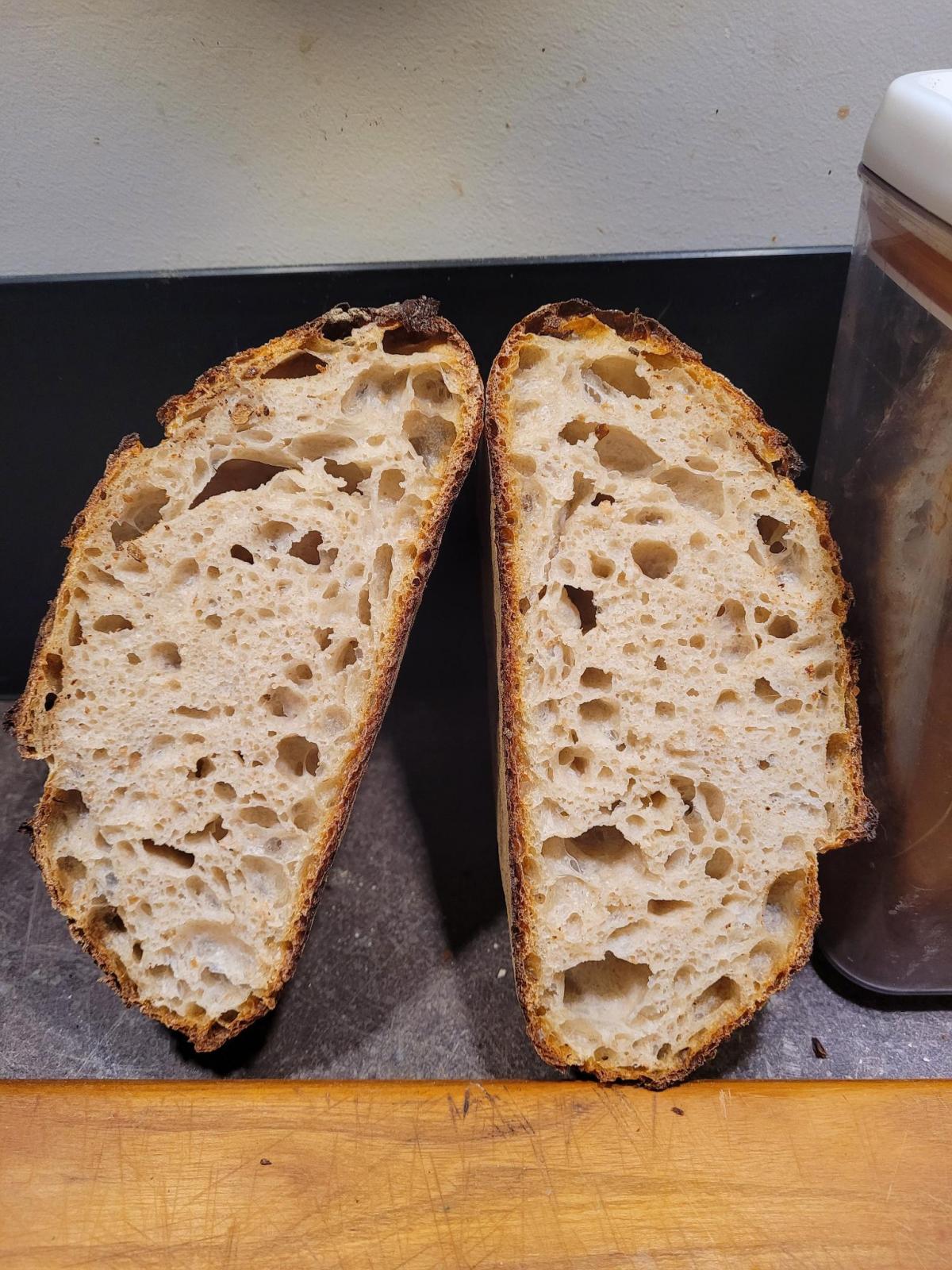
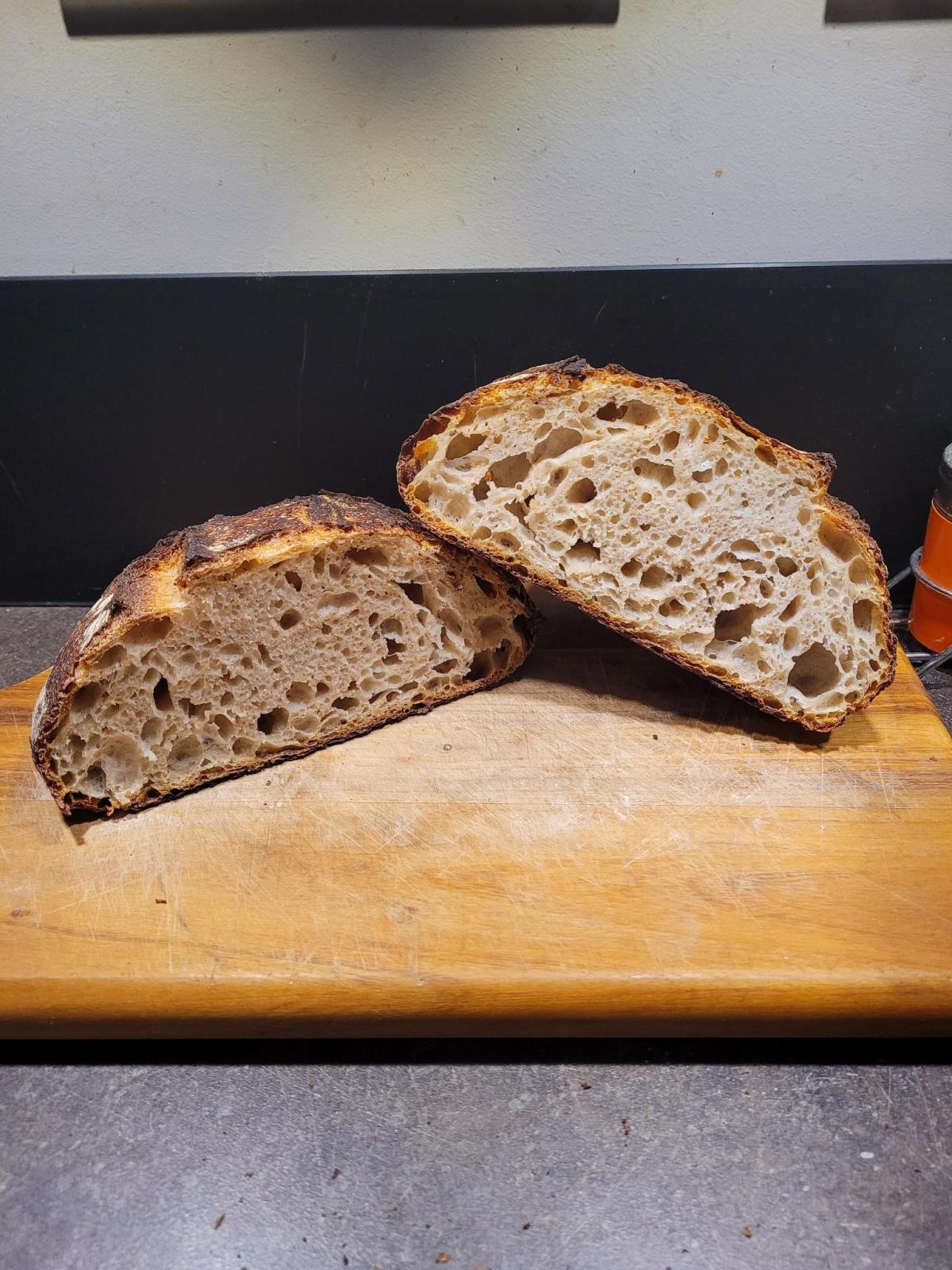
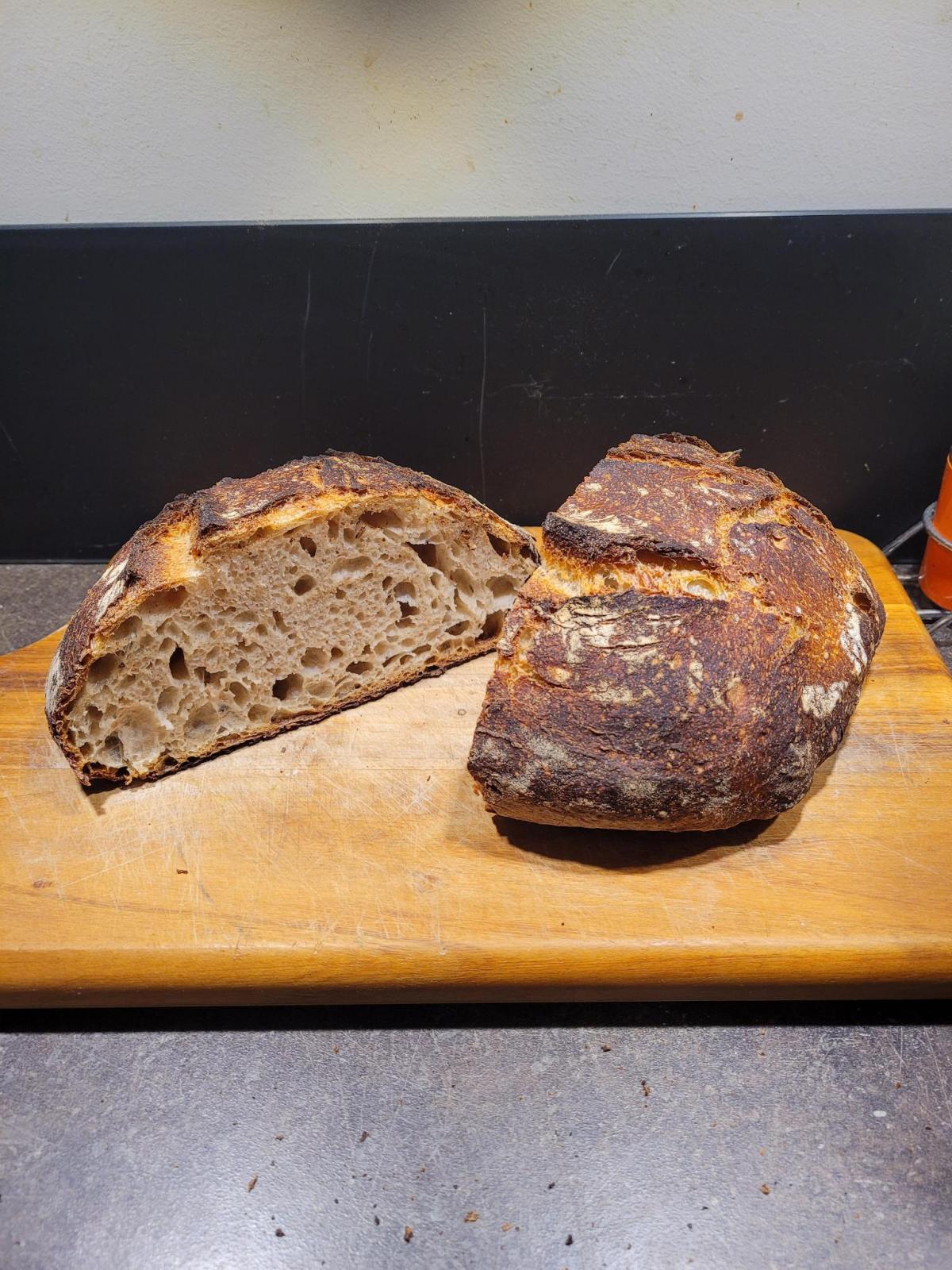
7h bulk fermentation and 45mn proofing at 25°C.
And such a lovely crust too. Looks delicious.
Starter clearly works and all it is now is getting used to everything and tweaking recipes to suit your needs which is what you're doing.
Bon Appetit.
for answering all these questions. Your help and patience was really appreciated !
Especially seeing the lovely bakes you're producing. Keep at it and before long keeping, maintaining and using a starter becomes second nature. Everything what I have explained is just like a recipe - a guideline! Find what works for you and tweak everything for the results you want. Forkish recipes are excellent but many people, even the most experienced bakers, can find them intimidating. To the different flours being used as a home baker and different temperatures (he wrote these for a relatively cool climate). Bear all this in mind. A great book to invest in is Hamelman's "Bread". You'll see a lot of his recipes on here for good reason... it's a solid book with lovely replicable recipes. Very popular.
Looks great! Kudos on staying with it.
This was a really enjoyable journey, and it's only the beginning. Your help was really appreciated ;)
People have made starters for generations, mostly without much or any knowledge of the biochemistry. Feed it regularly, keep at it and don't play complicated games. Some starters will subside after an initial burst, some will not.
I used Maurizio's method here https://www.theperfectloaf.com/7-easy-steps-making-incredible-sourdough-starter-scratch/
What I did was use distilled water (to avoid chlorine and yes, I know about the minerals), used an organic whole wheat flour since I didnt have rye around and simply followed that method. Mine was one of those that didn't ever subside which makes it easier because there's no period of wondering what happened, but the key is to persevere and not start trying a myriad of different things.
Thanks, just feeding 2:1:1 once a day, waiting for the miracle to happen !